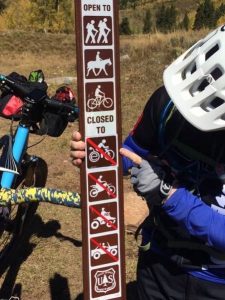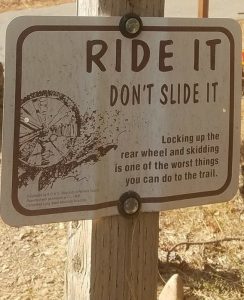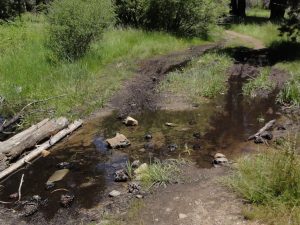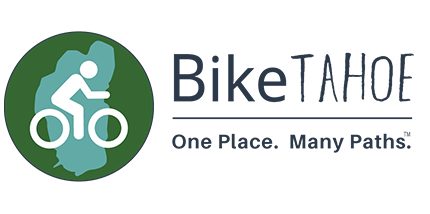7 Tips to Know Before You Go Mountain Biking
Mountain biking in the Lake Tahoe region, and other high alpine areas, provide excellent opportunities for adventure and connection with nature. But you must know before you go to help ensure you have a safe and enjoyable experience. Below are 7 bike tips to know before you on the trail that can help guide you.
To know before you go means being familiar with your bike, ability level, and the area you plan to ride. You will want to match your bike, skills and fitness levels appropriate to your ride. It is equally important to be self-sufficient with supplies to hydrate, have a snack, a tool kit, and a windbreaker when weather conditions change. If you are new to the area, check with knowledgeable sources (local bike shop, trail maps, or local friends) before heading out onto a single-track trail.
7 Bike Tips to Know Before You Go on the Trai

Check out trail signs before you go.
Ride Open Trails Only. Respect trail and road closures (ask if uncertain); avoid trespassing on private land; and check trail head signs for guidance. If you are riding an E-bike, know before you go on trails that are closed to E-bikes. Federally designated Wilderness areas are also closed to all bicycles. If you are planning to ride the famous Tahoe Rim Trail know that it is open to cyclists on even date days while the other days are open for hikers and equestrians.
Know Your Place in Space. Once at the trail head look around and get your bearings where you are and orient yourself to specific topographical features like mountain peaks, valleys, creeks, lakes, and even buildings and neighborhoods. These features can continually provide reference points as you navigate your way during your ride.
Keep in mind that riding in Tahoe is like riding in a giant bowl. One can get disoriented climbing to elevation or traversing cross-county through the forest and in canyons. So keep in mind that downhill trails will eventually cross a key road to help you return to your intended destination.
Take Time to Hydrate. Drinking water is essential in the high altitude. The high elevation, low humidity and hot dry temperatures during the summer months can contribute to dehydration, fatigue, cramping, faintness, dizziness, headache and nausea – similar symptoms associated with Altitude Sickness. It is a good practice to hydrate well before your ride and then take a drink about every 15 minutes during the ride. Adding supplements like electrolytes can also be helpful for long rides.
Take plenty of drinking water using either water bottles or backpacks. Avoid drinking the clear water from the streams and lakes as many of them may have Giardia – an amoeba that can cause abdominal pain, cramps, nausea and diarrhea.

Friends on the trail
Buddy System. The potential for unforeseen events to happen while riding is present. It is strongly recommended that you ride with a buddy whenever possible. Should you decide to ride alone tell someone where you will be riding, when you expect to return, and/or take a cell phone for emergencies. Keep in mind that because of Tahoe’s mountainous landscape, cell phone coverage is sporadic in certain areas. When alone and needing assistance, dial 911.
Share the Trail. Designated mountain bike trails in Tahoe are multi-use trails in which hikers, equestrians and in some cases motorcycles and ATV’s may also use. Let your fellow trail users know you are coming. A friendly greeting or bell is considerate and works well. Anticipate other trail users around corners or in blind spots by slowing down. Show your respect when passing others on the trail by slowing to a walking pace or even stopping. Yielding means slowing down, establishing communication, and being prepared to stop, if necessary.
When encountering horses always be prepared to dismount, yield the trail, and allow the horse and rider to pass. Check in with the rider for advice on how they would like you to proceed. Speak to horses in soothing tones, and encourage equestrians to stay on the trail.
Right of Way. Hikers and equestrians have the right of way, as they are the most vulnerable to higher speed bikes. Uphill riders have the right of way, and downhill riders should slow down if there is sufficient passing room, or come to a complete stop off to the side of the trail to allow the uphill rider to pass.

Ride it. Don’t slide it!

Avoid riding through wet zones. Walk your bike.
Leave No Trace. Be sensitive to the land beneath you. Practice low-impact cycling. Know before you go what the trail conditions are for the day. Recognize different types of soils (hard pack, sand, rock, decomposed organic material, muddy, etc.) and ride appropriately. Avoid locking your rear brake and skidding. Skidding can destroy the trail tread and cut ruts that when water is present contributes to soil erosion. Do not cut switchbacks, and be sure to pack out at least as much debris as you packed in.
Thank you. Adopting and sharing these 7 Bike Tips to Know Before You Go mountain biking can help build our community by demonstrating our caring for our fellow trail users and the Tahoe Eco-system.


